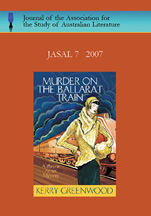Riders in the Chariot: A Tale for our Times
Keywords:
patrick white, modernism, elitesAbstract
This article rereads Patrick White's Riders in the Chariot against some of the past criticism of the text. It argues that the text has much to say about the contemporary politics of fear operating in Australia and demonstrates that many of the historical readings of White as an elitist, alienated Modernist cannot be sustained. The contemporary relevance and force of this novel arises from a double movement: the beauty of White’s prose operates continually to allow us to perceive the “infinite in everything” but it also helps us understand the absolutely ordinary fears and insecurities of the suburban Australian consciousness. Through the ordinary everydayness of his Australian characters (other than the riders) we see all too clearly how the ignorance and prejudice of a very small few have the ability to snowball with catastrophic consequences. Himmelfarb, in the face of horror, turned away from literature believing that intellectual reasoning had failed humanity. Today it is the fear of intellectual reasoning that has the potential to make us all less than we have the potential to be.Downloads
Published
2008-03-05
Issue
Section
Articles
License
The copyright for articles in this journal is retained by the author(s), with first publication rights granted to the journal. By virtue of their appearance in this open access journal, articles are free to use with proper attribution in educational and other non-commercial sectors.Attribution-NonCommercial-ShareAlike 2.1 Australia
This work is licensed under the Creative Commons Attribution-NonCommercial-ShareAlike 2.1 Australia License. To view a copy of this license, visit http://creativecommons.org/licenses/by-nc-sa/2.1/au/ or send a letter to Creative Commons, 543 Howard Street, 5th Floor, San Francisco, California, 94105, USA.
How to Cite
Riders in the Chariot: A Tale for our Times. (2008). Journal of the Association for the Study of Australian Literature, 7, 32-45. https://openjournals.library.sydney.edu.au/JASAL/article/view/9711

